I. Migration
“no one leaves home unless home is the mouth of a shark…”
According to the United Nations, there are currently more displaced people on the planet than at any other time in recorded history. Nearly sixty million people have fled or have been driven from their homes on account of war, violence, political destabilization, or severe economic conditions, compared to around 38 million a decade ago. 1 out of every 122 humans on this planet is currently a refugee, and 9 out of 10 of them are in regions considered to be underdeveloped by international standards. While the Syrian war is currently the largest contributor to such displacement, displaced people hail from every corner of the world, from Haiti to Pakistan to Senegal to Colombia.
More than half of the world’s sixty million refugees are children.
* * * * *
“you only run for the border when you see the whole city running as well…”
Refugees flooded into Europe in record numbers last year, comprising the largest influx of migrants from outside the European continent in modern times. While the majority of refugees fled from Syria, Iraq, and Afghanistan, they came from every corner of the world; from Haiti, Mali, Senegal, Eritrea, Pakistan. The vast majority of them landed on Greek shores, but they also flooded into Hungary, Italy, and Turkey, desperately hoping to eventually reach Northern Europe.
They are fleeing civil wars, sectarian conflicts, and widespread poverty caused by both natural disasters and social forces. They are leaving their homes, their ancestral villages, and their families, with many never to return, risking their lives in an attempt to reached a promised land of safety that in reality is often quite harsh and unwelcoming. While the conflicts and tragedies that drive them from their homelands are varied in both complication and scope, nearly all are bound by the common roots of imperialism and colonialism.
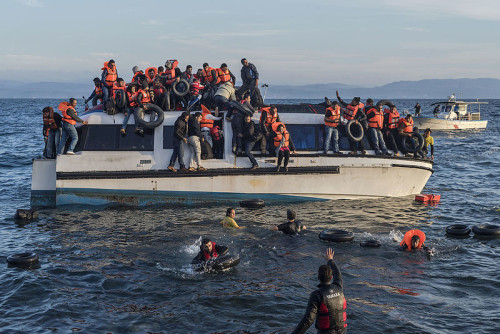
Iraqi and Syrian migrants land on the island of Lesvos. Photo by Ggia.
In response to this “migrant crisis,” the affected countries of the European Union (mind you, the very same countries that have financially benefited for centuries off the same imperialist meddling that is at the root of the current conflicts) have recently moved to close borders, restrict free movement, and otherwise thwart the attempts of the refugees from reaching Northern Europe.
The rhetoric employed by both government and media throughout Europe in order to justify these actions follows the same tried-and-true scare tactic formula that immigration foes have effectively used throughout recent history: dire warnings that the migrants will “game the system,” “refuse to assimilate,” “steal jobs,” as well as contribute to “moral decline” on account of their differing “culture” and “values.”
American lawmakers and media personalities have also similarly politicized the refugee crisis, using both the aforementioned rhetoric as well as fears of “terrorism” in order to turn an easily manipulated populace against the idea of supporting refugee resettlement in the United States.
Their tactics are no different from the rhetoric of a century ago, even two centuries ago. The exact same dire warnings were once used by American “settlers” against the Irish, and later the Italians, Chinese, Greeks, Portuguese, Hungarians and Jews. Nowadays they are used against immigrants from both Latin America and the Middle East. And both them and now, such arguments only further benefit the ruling class at the expense of the oppressed.
“go home blacks, refugees, dirty immigrants, asylum seekers, sucking our country dry…messed up their country and now they want to mess ours up…”
But while this rhetoric negatively affects the level and effectiveness of humanitarian efforts, it obviously does nothing to stem the tide of people fleeing their homelands. Well over a million refugees flooded into and moved through Europe last year, comprising the largest influx of migrants from outside the European continent in modern times.
“the dirty looks roll off your backs maybe because the blow is softer than a limb torn off…”
II. Push
A hundred years ago there were also a million people per year moving through Europe. But instead of risking their lives to reach Greece, Hungary, and Italy, they were risking their lives to migrate from these very countries, in many cases due to sociopolitical conditions very similar to those that are triggering the current migration crisis. They fled war, poverty, natural disaster, starvation, and religious persecution, embarking on perilous voyages across the sea only to arrive in a foreign country that was harsh and unwelcoming, treated them with great prejudice, and often subjected them to severe exploitation.
Where did they flee to, you ask?
They fled to America.
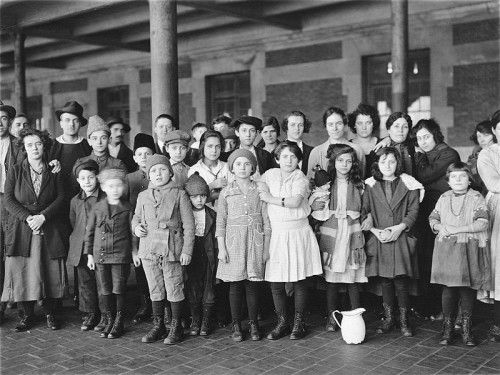
Immigrant children at Ellis Island, 1908. Public domain.
* * * * *
“you only leave home when home won’t let you stay…”
When it comes to why refugees are currently fleeing Iraq or Syria, the basic answers are readily at the tip of everyone’s tongue. War. Conflict. Terrorism.
But ask the average American why their own ancestors came here, and they tend to respond with either or both of the following vague answers: they either came for “religious freedom” or for “a better life.” And while these answers are not necessarily untrue, they painfully oversimplify and sanitize the myriad of complex factors that triggered massive waves of immigration to America.
Immigration functions as a “push” or “pull” phenomenon: in short, those who migrate from one place to another are either being pushed out of a specific region due to specific negative sociopolitical factors and/or they are being pulled into a specific region due to specific positive factors, factors that frame the belief that immigrating to said region will allow for “a better life.” The standard American narrative around the immigration journey emphasizes and glorifies both the pull of America in terms of its religious freedom and promise of prosperity while stressing the great sacrifices that our ancestors made coming to America.
But what is often overlooked and forgotten in that narrative are the very reasons that so many made such a sacrifice in the first place. The pull factors are stressed, but the push factors that led to large-scale immigration to America are minimized and rarely ever summarized beyond the simple statement of “a better life.” Which then leaves unanswered the specific question of why thirty million people fled Europe over a span of a hundred years for a better life in the first place.
And in ignoring that question, we ignore both our roots as a nation as well as the struggles of our ancestors.
One of the most crucial and yet most overlooked aspects of white American identity is the fact that with very few exceptions, we are all descended at least in part from people who fled from war, persecution, starvation, and/or poverty, and who risked their lives and left everything they knew behind to do so. We categorize them as “immigrants” or “pioneers,” but in reality so many of them were refugees, no less refugees than many of those currently fleeing the Middle East for Western Europe.
* * *
“you have to understand that no one puts their children in a boat unless the water is safer than the land…”
In November of 1913, sixteen year old Sofia Manossadakis arrived on Ellis Island after a three-week journey at sea. Sofia and her three siblings were among nearly a million immigrants that arrived that year, mostly from Central and Eastern Europe. For her, a better life meant the chance to escape the sectarian violence and political instability that had characterized her homeland of Crete for well over two centuries.
The Ottoman Empire took possession of Crete in the mid-1600s after several hundred years under Venetian rule, and the Greek Christian population of Crete spent the next two hundred and fifty years consistently and actively resisting Turkish rule, culminating in several notable revolts and rebellions. From the Daskalogiannis Revolt in 1770 to the numerous Cretan revolts throughout the 1800s, the island was consistently destabilized by violence. Uprisings and riots in the mid-1890s culminated into the Cretan Revolt of 1897, which directly coincided with the Greco-Turkish War being fought on the Greek mainland, a war fought over the possession of Crete. The overlapping of these two conflicts and the resulting violence led to an intervention by the great powers, who declared the Cretan state an autonomous territory under Ottoman suzerainty.
It was also in 1897 that Sofia Manossadakis was born in Livaniana, a tiny settlement high in the mountains of Sfakia on the south-west coast of Crete.
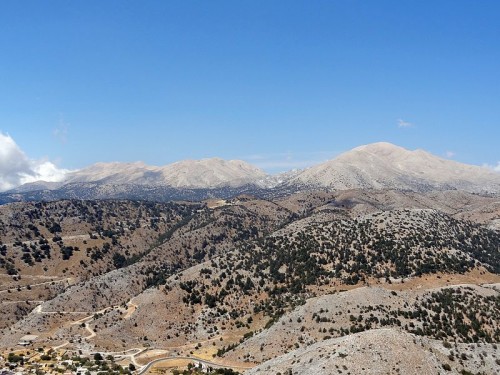
The ‘Lefka Ori’ of Sfakia. Photo by Oltau.
Sfakia had been a stronghold of Christian resistance against the Ottomans since the Daskalogiannis Revolt, which originated in the mountains of Sfakia in 1770 and was brutally suppressed by the Turks. The village of Livaniana itself had lost nearly half its population during the uprisings of 1821, and had suffered further violence in the subsequent uprisings throughout the rest of the century.
By the time Sofia was born, the population of Livaniana as well as the surrounding villages was significantly dwindling, with more and more peasants either fleeing for mainland Greece or risking the voyage to America in order to escape the violence. The autonomous designation of the Cretan state did little to quell the chaos, with sectarian violence between Christians and Muslims breaking out throughout the first decade of the twentieth century. Revolts in 1905 prompted another intervention by the great powers, and the Young Turk Revolution in 1908 prompted Crete to declare union with Greece. The international community refused to recognize the union, triggering yet another series of revolts. A few years later, the Ottoman Turks went to war with Italy over control of Libya and were easily defeated, a defeat which prompted the members of the Balkan League to then declare war on a weakened Ottoman Empire.
It was against this backdrop, with seemingly no end to the violence and hostilities, that Sofia, her two sisters, and her older brother sailed for New York on the RMS Carpathia, which departed for New York from Trieste on November 5, 1913. Their passage was paid with help from their oldest brother, who had established himself in Massachusetts after immigrating a few years earlier and who they planned to reunite with in America. Their parents stayed behind in Crete, never again to see their children.
A little over a week later, while the Manossadakis siblings were partway across the Atlantic, the Greeks and Ottomans signed a treaty officially ending the hostilities between them, at which time the Cretan union with Greece was finally recognized. Only a few days after the Carpathia docked in New York Harbor and Sofia was legally admitted to the United States, the Greek flag was finally raised at Firkas Fortress in Chania, Crete after centuries of struggle.
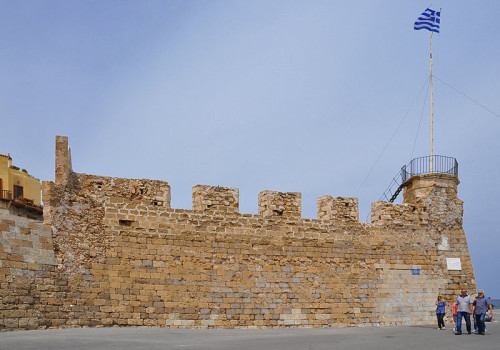
Firkas Fortress, Chania, Crete. Photo by Moonik.
* * *
“no one spends days and nights in the stomach of a truck…unless the miles traveled means something more than the journey…”
Nobody will ever know for certain how Manuel Cardozo made his way to America, but by far the most plausible scenario is that he smuggled himself to New England on one of the countless whaling ships that came through the Azores on their way across the Atlantic.
Thousands of Azoreans made their way to port cities in New England via whaling ships in the late 1800s, most notably Bristol, Rhode Island and Fall River, Massachusetts. Those who could leave the Azores freely usually sought employment on the ships in exchange for passage to America, but those who could not leave freely had no choice other than to travel as a stowaway. And Manuel Cardozo could not leave freely.
Uninhabited when claimed by Portugal in the early 1400s, the Azores were first settled by Portuguese prisoners under the direction of Prince Henry the Navigator. “Free” settlers soon followed; peasants from the Algarve and Madeira, Sephardic Jews and New Christians who were expelled from Spain and Portugal under the Catholic monarchs, former Moorish slaves and prisoners exiled from the Portuguese, as well as peasants and merchants who migrated from war-torn Flanders. The islands were established as series of ports serving the Portuguese crown, and for the next five hundred years the Azores were treated similarly to many other colonial possessions in that they served a dual purpose as a source of profit for the mainland and a convenient place to exile the unwanted and dispossessed. The well-being of the peasants themselves was rarely an afterthought.
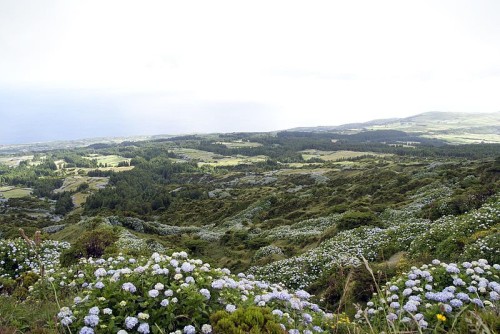
Faiai Island, Azores. Photo by Luca Nebuloni
For the next five hundred years those living on the Azores suffered through poverty, starvation, famine, and a series of wars initiated by both the Spanish and Portuguese crowns. With a terrain inadequate for sustaining the population in even the best conditions, and a land-ownership system that prevented peasants from ever attaining any sort of upwards mobility, many Azoreans started to again migrate beginning in the 1600s, most often to the newly-founded Portuguese colony of Brazil.
Those who stayed continued to suffer for generations, and a series of crop failures combined with natural disasters in the mid-to-late 1800s once again spurred a wave of migration driven by desperation and poverty, this time to the New World. However, while so many of the impoverished and oppressed throughout Western Europe were able to migrate via steamship to Ellis Island, the illiterate peasants of the Azores faced unique barriers to “legal” immigration, given that it was the most impoverished region in Western Europe.
Not only was the cost of and access to a steamship voyage to America financially unfeasible for most Azorean peasants, but males who had yet to complete the mandatory period of military conscription required by the Portuguese government were legally barred from leaving the islands unless they posted the equivalent of $300 as bond, a figure ten times higher than the $30 average steamship passage that was already out of reach for most.
As a result, the whaling ships functioned as the primary means of immigration for Azoreans, whether legal or illegal, whether as employee or stowaway. And at sixteen years old, Manuel Cardozo had every reason to take his chances as a stowaway rather than spend the next four to eight years of his life helping to expand the Portuguese empire only to then to be forced back into a life of ever-worsening poverty and starvation with absolutely no hope for mobility.
Manuel arrived in Bristol, Rhode Island around 1899, established himself and found work amongst the Portuguese community in Bristol, and a few years later married a woman of Portuguese descent who “legally” came to America by way of Hawaii. And despite lifelong illiteracy and a lack of fluency in English, Manuel supported a family of sixteen through hard work and determination, finding employment in factories and second jobs as a night watchman throughout the first half of the twentieth century.
He lived and died as an “illegal alien” in this country, having never received a single benefit throughout his entire life, but his sacrifice and hard work (along with the magical powers of “assimilation” and “whiteness”) ensured that his children and grandchildren had the opportunity to both contribute to and benefit from the “American Dream.”
III. Land
On one hand, it can be fairly stated that people have been driven off of land through actualized or threatened violence since the beginning of recorded history. But the specific geopolitical and economic forces and conditions that triggered both the colonization of the Americas as well as the eventual push of mass migrations of Europeans to the New World were dependent on a very specific process known as “primitive accumulation.”
Primitive accumulation is the process of seizing land that was previously regarded as commons for the purpose of commodification, a process that first developed in Europe during the Middle Ages and was central to the transition from feudalism to capitalism. In Karl Marx’s words, primitive accumulation was “the historical process of divorcing the producer from the means of production.” Those displaced producers, generally known as peasants, are then reliant on the market for survival, which tends to force them into urban areas seeking wage-labor jobs, leading to industrialization due to the sudden and enormous pool of desperate workers.
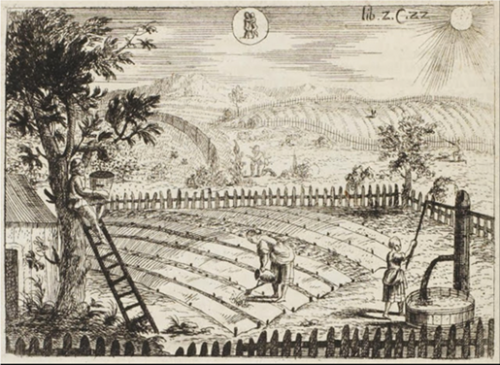
The Enclosures of Medieval England. Public domain.
This process, which echoes and repeats clearly and continuously from 12th century Flanders to the effects of NAFTA in the late 1990s, still continues to this day in places such as Nigeria and the Amazon, triggering the same consistent patterns of violence and displacement that have been fueling migration for hundreds of years. Waves of primitive accumulation throughout Western Europe from the 16th to 18th centuries not only drove direct emigration, but also triggered a cascade of socioeconomic conditions that led to later waves of migration, most notable the thirty million immigrants that came to America between 1850 and 1934.
Primitive accumulation also factors starkly and prominently in the accumulation of the land the eventually became America in the first place. This accumulation, which came at the price of around 100 million indigenous people, quickly developed into an economic powerhouse due to its investment of 20 million African slaves, which in itself can be seen as another form of primitive accumulation.
Going back even further, it was in fact primitive accumulation that financed the “discovery of America” and sparked the colonial era in the first place.
* * *
In the sanitized version of history propagated mainly through American public school textbooks, Christopher Columbus discovered America while sailing under the flag of Spain. This narrative is problematic for many reasons (most of which others have elaborated on much better than I ever could), but aside from its sanitization of details and pro-colonialist framework, it is also most often problematically presented as having occurred in a vacuum.
While such a voyage, whitewashed or not, may have signaled the “birth” of the New World from a European colonial perspective, the voyage occurred at a pivotal moment in European history, standing as a symbolic consummation of a fledgling power that came to be known as Spanish Empire. The rise of that power, a victorious culmination of hundreds of years of warfare, would not have been possible if not for the sudden and consistent influxes of wealth generated through what was arguably the very first instance of what came to be known as primitive accumulation.
In 711 AD, Moorish armies invaded the Iberian peninsula, establishing what would eventually be known as the kingdom of Al-Andalus. Within a decade, the vast majority of the peninsula was under Muslim rule, and the various Christian kingdoms in Iberia spent nearly eight hundred years fighting to reclaim Iberian territory from the Moors.
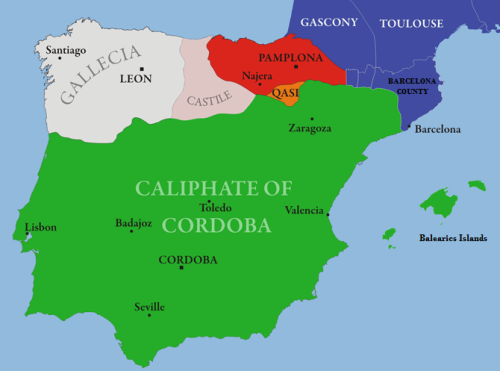
Al-Andalus and the surrounding Christian kingdoms, circa 1000 AD. Public domain.
This campaign, known as the Reconquista, gained strength in the 9th century with the alleged discovery of the remains of St. James in Galicia, transported and then enshrined in a town that came to be known as Santiago de Compostela. This discovery sparked a pilgrimage route through northern Spain that quickly became the most popular medieval pilgrimage route through Europe. The influx of pilgrims across what became known as the Way of St. James was of both financial and social benefit to the Christian kingdoms of northern Spain, who were able to strengthen their position and finance further mercenary armies to reconquer Iberia from the Moors.
The Moors, meanwhile, had imported merino sheep from North Africa into Iberia, and as the kingdom of Castile gradually retook land from the Muslim kingdom, the Christian aristocracy recognized the potential for merino wool as a lucrative cash crop that could reliably fund the Reconquista.
Common lands throughout Castile were then seized for the purpose of sheep grazing. The Castilian crown quickly prospered and amassed significant wealth due to the demand for wool in northern Europe at the expense of the peasantry who were displaced en masse and left to starve. Unlike the later cycles of primitive accumulation that affected England, there were no industrialized cities desperate for exploitable wage labor for the peasants of Iberia to flee to. In many circumstances, the only viable (and bitterly ironic) alternative to starvation for Iberian peasants was to join the very armies that were funded by the commodification of the lands they once lived on.
By the mid-1300s, the crown of Castile controlled the majority of the Iberian peninsula, and a hundred years later the marriage of Isabella of Castile to Ferdinand of Aragon created a consolidation of power that would bear fruit in 1779 when Ferdinand succeeded his late father as king. The combined union of the kingdoms of Castile and Aragon then successfully conquered the last Muslim kingdom of Granada thirteen years later, in January of 1492.
It was only weeks after the fall of Granada in 1492 that the court of the kingdom of Castile agreed to finance Columbus’ voyage. Columbus had been presenting his case to the Spanish court for a few years at that point, but the completion of the Reconquista meant that the profits from Castilian wool were no longer needed to fund armies and mercenaries. That wealth could now be used to fund “exploration” with the purpose of acquiring further wealth.
And so as peasants faced the choice of migration, starvation, or conscription while sheep comfortably grazed on their former lands, Columbus set sail for what he thought would be the Indies financed by the profits derived from those sheep. The voyage, as we know, did not lead him to the Indies, but instead he landed on the shores of an island known to its Taino inhabitants as Guanahani.
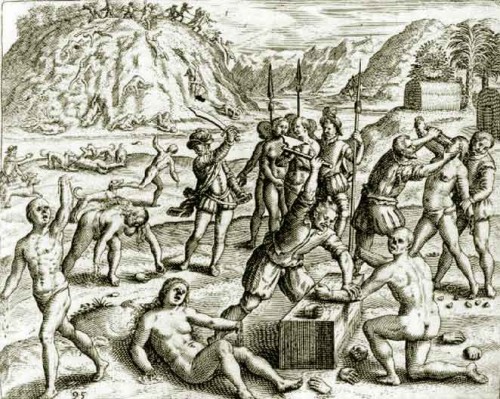
Illustration of Columbus’ men massacring the Taino. Public domain.
The Italian explorer and his crew expressed their gratefulness towards Taino hospitality by committing horrifying atrocities against the Tainos and by seizing several Tainos as slaves that they then took back with them to Spain, an action repeated by Columbus on subsequent voyages, as well as by Amerigo Vespucci a few years later. By the time Columbus left what was by then called Hispaniola for the last time, the Taino population had been reduced from eight million to less than 100,000. Not long after, slaves from other islands had to be imported to Hispaniola from other possessions of the Spanish crown as the native Taino population had been decimated by murder and exploitation to the point of extermination.
The taking of both land and slaves for the sole purpose of exploitation and profit eventually progressed into the accumulating genocidal force that we know today as global imperialism, and those takings are the foundation on which the United States was built.
IV. Legacy
A hundred years after immigration peaked at Ellis Island, the New World that once provided a remedy for the intertwined issues of land and scarcity in Europe is now the epicenter of an end-stage crisis that is a direct continuation of the same cycle that produced America in the first place.
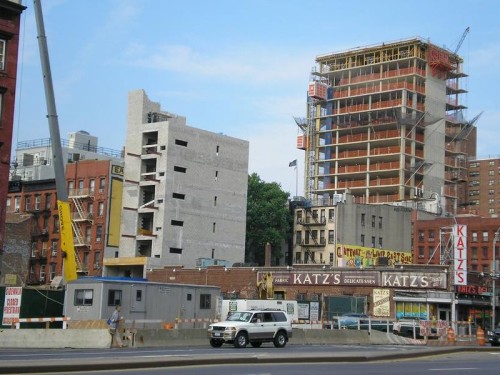
Gentrification on the Lower East Side of Manhattan. Photo by David Shankbone.
The crisis is most often coded in the languages of development, policy, and economics, deliberately isolating it from its historical roots or patterns, but it is neither a new process nor one confined to the terrain of cities or the field of urban planning. While one was obviously a much more physically violent and bloody process, especially on American soil, overall there is little difference between the mechanisms of gentrification in America and those of colonization as a whole. The specific modes and methods of violence and oppression differ greatly, but both are processes sparked by the intertwining forces of scarcity, commodification, and speculative profit, the same processes that have been driving displacement and migration for centuries and that forced so many of our ancestors to leave their homelands for the New World.
In turn, several generations after the completion of the massive land grab that was America, the descendants of that massive wave of immigrants are now learning the hard way that the limits of the “American Dream” are congruent with and dependent on the physical limits of available, affordable and viable land. But unlike a century ago, this time there is no viable pull, no newly colonized landmass for the current crop of landless peasants to settle on and continue the cycle of oppression.
* * *
In the fall of 2007, I sold nearly everything I owned, packed what I had left into my van, and drove across the country from New York City to Oregon. I had little to no connections in Oregon, no job prospects, and no concrete plan on how I would survive. But despite these unknowns, I knew that the possibilities that lay before me on the other side of the country still held more promise than what I was leaving behind.
I was an economic migrant, driven from NYC at the height of late-stage gentrification. I could not find an affordable piece of land to live on, which forced me to leave my “homeland” in order to seek out “a better life” on the West Coast where land was not as scarce and in demand.
I was the first American-born member of my direct lineage to make such a journey. Neither my parents nor my grandparents ever needed to migrate for socioeconomic reasons, as the privileges we call whiteness, assimilation, and citizenship allowed them to generate wealth and stability through the American Dream of property ownership. But my journey into adulthood was congruent with what’s now been referred to for at least two decades as an “affordability crisis,” and property ownership is now out of reach for a significant portion of my generation due to a manufactured scarcity of viable housing.
This scarcity of available and viable places to live combined with job scarcity and depressed wages has not only led to a newly proletarianized white middle class (in as much as the opportunity to generate wealth through land ownership has been newly denied to them), but it has also led to widespread migrations from economically saturated urban areas as a result of inflated housing prices. And those migrations inevitably result in triggering the cycle of gentrification in the areas that they settle.
A decade later, three thousand miles from my homeland, I myself am a part of and am witnessing this very effect. The same cycle of gentrification that drove me from New York a decade ago has now thrown my adopted home of Portland in crisis, erasing any potential of a better life in terms of economic security. And yet, despite this crisis, I am still in an infinitely safer position than some of my fellow economic migrants, whose lack of privilege in contrast to my own has resulted in their being forced to exist in some of the most dangerous and squalid conditions imaginable.
* * *
Across the street from my building in downtown Portland, a homeless camp slowly but steadily formed over the past several months. While homeless camps have been sprouting up with frequency throughout America for at least a decade now, the growth of a camp literally in my front yard in tandem with the growing refugee crisis in Europe made the similarities and shared causes and circumstances impossible to ignore.
In technical terms, “refugee” is reserved for displaced people who cross a border seeking refuge. Those who do not cross a border but are still displaced are referred to the UN as “internally displaced persons.” And while the UN may not categorize the ever-growing population of homeless in the United States as internally displaced persons in terms of their reports and statistics, there is little difference between the sociopolitical forces that produced the camp across the street and the sociopolitical forces that produce many refugee camps around the world. Once we strip away the specific signifiers (“homeless,” “bums,” “travelers,” etc.) that we use in our culture in order to characterize them, they are simply landless peasants, displaced persons, economic refugees and migrants.
One of the great myths that drives homeless policy on the municipal level in the United States is the belief that the majority of homeless people in any given area are not actually local but from somewhere else, and that they migrated to the city in question because it’s somehow better for homeless people there than wherever they came from. Often presented as incontestable truth by both local politicians and business owners, the myth is used as a justification for not funding services or shelters, as it is stressed that doing so will “enable” and “attract” these supposed masses of migrants from elsewhere.
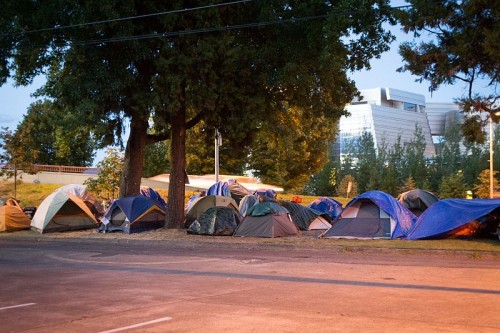
Homeless camp in Eugene, Oregon. Photo by Visitor7.
That this idea is myth as opposed to truth is incontestable: federal data consistently shows that the majority of homeless persons within any given urban area are local to at least the county if not the city itself. And yet this myth is still consistently and successfully wielded as a weapon as it serves the ruling class on multiple levels. Not only does it exploit the same fear-of-others tendency that is also central to anti-immigrant rhetoric, the myth also serves to placate and flatter the citizenry and to create a false impression of economic stability within the community. By positioning the community at issue as a “draw,” the myth reinforces the idea that the community is such a desirable place to live that homeless folks would travel from all over the country to take advantage of the quality of life that the taxpayers enjoy, as well as create the false assumption that poverty is not a severe issue in their community.
If the visibly poor are conveniently regarded as being from elsewhere, denying and/or hiding the severity of poverty in any given community becomes much less of a challenge. Poverty itself becomes the other.
Such inaction, combined with criminalization, only exacerbates the problem of homelessness. While the federal government estimates around 600,000 homeless people currently living in the United States, that number is widely regarded as a dramatic undercount due to the federal government’s narrow definition of homeless combined with a significantly flawed data collection process. When the definition of homeless is expanded enough to include those living in cars, motels, and those who are temporarily living with family and friends, the number of American displaced persons and economic refugees rises to well over eight million people.
Though not (yet) as severe in its scope, the “homeless crisis” is to present-day America what the “refugee crisis” is to present-day Europe, and the myth of the other, the “migrant” seeking to “take advantage” of local communities echoes with eerie similarity throughout the politics and rhetoric around both crises and across two continents. And of course, that rhetoric is no different from the rhetoric that so many of our ancestors in America once faced.
It is for these reasons that I can’t walk past the camp without thinking simultaneously of the refugee camps of Europe, of my own economic migration, of the journeys of my own ancestors, and of the cycles of accumulation and displacement that lies the root of all of it.
* * *
“It is the basic contradiction in our entire history as a nation. The first European settlers who landed on these shores saw themselves as creating a great new experiment in democratic government. Yet they were enslaving a whole population of human beings, Africans, and committing genocide against the indigenous peoples of North America. As a nation, we have never really dealt with this contradiction. We’ve only picked around the edges of it.” – Anne Braden
On one hand, I am undeniably a child of empire, born and raised on unceded Lenape land that colonial occupiers renamed “New Jersey” after driving the Munsee out in the 1600s. I am a product of the same American Dream that is theoretically afforded to everyone under the protection of this empire, and despite my lack of access to land ownership I am the recipient of an immeasurable amount of privilege purely on account of my European ancestry.
On the other hand, while raised in relative stability as the descendant of two generations’ worth of landowners, once I step back any further in my family line I am a descendant of refugees and illegals. And those ancestors, who suffered through war and poverty before leaving everything behind to come to America, were in turn descended from countless generations of landless and exploited peasants.
It is variations of this contradiction that most white Americans cannot escape, the often coterminous roles of oppressed and oppressor. And in facing that contradiction we also must face our ethical obligations and closely examine our actions and attitudes towards both historic and present victims of oppression. For whether it’s the homeless already in our back yards, or the refugees risking their lives to reach our borders, to turn our backs and other them is not only a refusal of basic decency and hospitality in the face of suffering, but a painful hypocrisy given the histories of so many of our own ancestors.
When we deny hospitality and safety to the displaced, when we refuse and dismiss those begging at our door seeking safety and relief from war and poverty, we in turn deny our own past, we dismiss the trials of our ancestors, and we erase our own truths.
V. Epilogue
A few weeks ago, the camp that had built up over months across from my building was suddenly and harshly evacuated by law enforcement, with dumpsters and personnel on hand to confiscate and destroy any trace left after the residents were forced to leave. A few days later, the refugee camp in Calais known as “the Jungle,” one of the oldest and largest refugee camps in Europe, was also bulldozed and evacuated.

DIsmantling homeless camp underneath the Steel Bridge. Photo by John Monroe.
In both cases, those displaced were given nowhere to go. They are without land, without possessions, once again victimized by a cycle of displacement that has been benefiting the few on behalf of the many for nearly a thousand years.
A cycle that will never end for as long as the value of land carries a higher worth than the value of people.
* * *
This piece is dedicated to the estimated 2,500 refugees who died at sea trying to reach Europe in 2015.
It was written under the guidance and with the persistent urging of my own ancestors, most notably my maternal great-grandfather and paternal great-grandmother, whose stories I shared in this piece.
What is remembered, lives.
* * *
The italicized quotes running throughout this first half of this piece are excerpted from ‘Home’ by Warsan Shire, a Kenyan-born Somali poet currently living in the United Kingdom. The poem in its entirety can be found here.
* * *
This column was made possible by the generous underwriting donation from Hecate Demeter, writer, ecofeminist, witch and Priestess of the Great Mother Earth.
The Wild Hunt is not responsible for links to external content.
To join a conversation on this post:
Visit our The Wild Hunt subreddit! Point your favorite browser to https://www.reddit.com/r/The_Wild_Hunt_News/, then click “JOIN”. Make sure to click the bell, too, to be notified of new articles posted to our subreddit.
In the fourth paragraph following the color map, a date is given as 1779. It must have been meant as 1479.